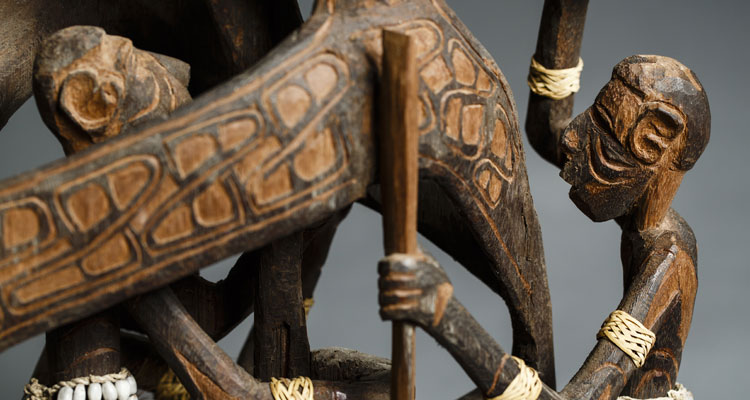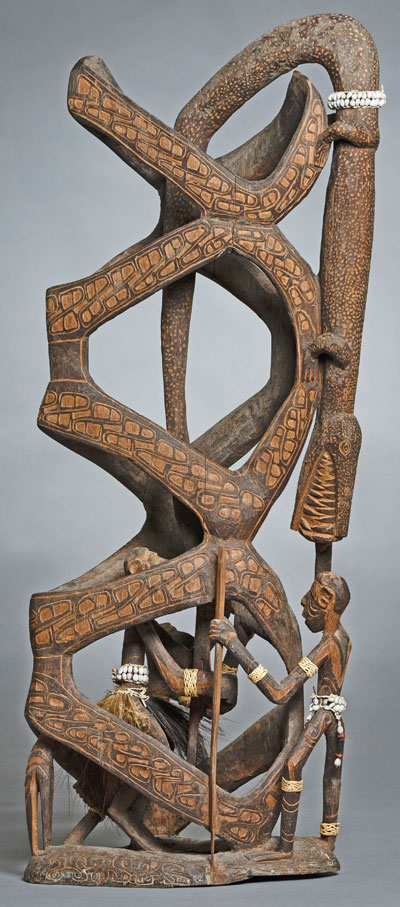How contemporary Asmat artists from southwestern New Guinea continue to draw on the imagery and skills passed down to them by their ancestors is the subject of a new exhibition at the University of St. Thomas.
The exhibit, “Now and Then: Innovation and Continuity in Asmat Art,” is free and open to the public and can be seen through July 31 in The Gallery, located on the second floor of the Anderson Student Center on the university’s St. Paul campus.
A reception marking the exhibit’s opening will be held from Friday, Feb. 19, from 5-7 p.m. All are welcome.
The Asmat people, known for their traditional and contemporary carvings, live in several hundred villages located along the vast system of rivers that flow into the Arafura Sea north of Australia. The challenges of reaching this part of New Guinea, with its swamps and lowland rainforests, meant the Asmat had little contact with the outside world until the 1950s.
The American Crosier Fathers and Brothers began collecting Asmart art when they first arrived there nearly 60 years ago. Their 1,400-piece collection was donated to St. Thomas by the Crosiers and the Diocese of Agats in 2007.
The collection, one of the most comprehensive of its kind in the United States, has since grown to more than 2,000 pieces and includes finely woven masks, intricately carved shields, long “spirit canoes” and tall ancestor, or bis, poles. The St. Thomas-based American Museum of Asmat Art continues to grow through donations from private collectors and by direct purchases from Asmat artists.
The 35 pieces selected for the “Now and Then” exhibition all come from the museum’s collection and most are being displayed for the first time. Two tall wooden shields in the exhibit demonstrate how Asmat artists are developing new styles that remain heavily influenced by centuries-old traditions. One shield, carved many years ago, is covered with abstract designs. The second shield, carved more recently, looks similar. However, on closer examination, the designs are not abstract but now depict recognizable animals.
Other examples that show similar changes include bamboo horns whose intricate surface carvings have inspired a variety of new art forms from decorative plaques to ashtrays. Some items on display were not even part of the Asmat culture prior to the arrival of the Crosiers, such as crucifixes. The exhibition includes a contemporary narrative carving that draws on elements of traditional Asmat mythology and imagery to portray the biblical account of Eve being tempted by forbidden fruit in the Garden of Eden.
One of the newest pieces on display was carved in 2012 by Ernest Dicem and depicts three humans intertwined within the roots of a banyan tree, and, unfortunately, one of the humans has a hand in the mouth of a crocodile.
The “Now and Then” exhibit was curated by Dr. Eric Kjellgren, director of the museum, with assistance from two St. Thomas art history graduate students, Jennifer Smith, a graduate of Cornell College in Iowa, and Elizabeth Madden, a graduate of the University of Missouri in Columbia.
In addition to the museum at St. Thomas, large collections of Asmat art and artifacts can be found at the Metropolitan Museum of Art in New York City and the Tropenmuseum in Amsterdam. In 2009, the Minneapolis Institute of Art displayed 72 pieces from the St. Thomas collection during a four-month exhibition. Some art historians believe that Asmat art influenced modernist and surrealist Western artists such as Henri Matisse, Marc Chagall and Pablo Picasso.
Exhibition hours are from 10 a.m.-4 p.m. Mondays through Wednesdays, from 10 a.m.-8 p.m. Thursdays, from 10 a.m.-2 p.m. Fridays, and from noon-4 p.m. on weekends. More information is available at (651) 962-5512 and the museum’s website.








